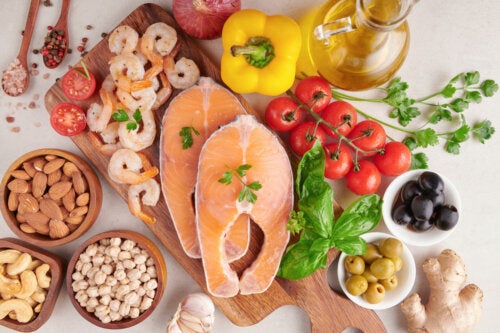6 Foods with Omega-3 that Benefit Brain Development in Babies
Foods with omega-3 help in the development of babies' brains, so they shouldn't be lacking in the diet during pregnancy and breastfeeding.

The health and good growth of babies will always be a priority for parents. Especially when we’re told that our children’s brain development depends on what we eat during pregnancy and after birth. Essential fatty acids, for example, are of great importance at this stage. Therefore, it’s important to know foods with omega-3 benefit your baby’s brain development.
By including a variety of these foods in the diet during pregnancy and breastfeeding, parents can ensure that they provide their baby with the essential fatty acids needed for optimal brain development and overall growth. Learn more below.
How are omega-3s involved in a baby’s brain development?
Omega-3 fatty acids are critical nutrients for the growing baby in the womb and for continued development after birth.
Within the omega-3s, there are specific fatty acids for brain development–DHA and EPA–which are transferred to the placenta through the umbilical cord.
In 2022, an article published in the International Journal of Food Properties revealed that fats contribute between 50% to 60% of a baby’s brain structure. Among these, DHA makes up 30% of the brain and 85% of vision.
EPA has a stronger effect on performance and mood, while DHA participates in neuron synapses. Both develop neuroprotective compounds.
For babies to obtain them, they depend on their mother’s diet during pregnancy or through breastfeeding. After 6 months, they receive it from their diet.
The recommended intake of these fatty acids during pregnancy and breastfeeding is 300 milligrams per day of DHA and 200 milligrams of EPA.
What are the main foods with omega-3? We’ll tell you below.
Foods with omega-3 that help babies’ brain development
The omega-3 fatty acids that are of great importance for a baby’s brain development are found in foods in their natural form, such as DHA and EPA, or as their precursors, alpha-linolenic fatty acid (ALA).
Here are the 6 foods that contain the most omega-3 to ensure adequate intake during pregnancy and breastfeeding.
1. Fatty fish
Evidence shows that consumption of a wide range of fish and seafood during pregnancy is associated with better neurocognitive development in children compared to those groups that don’t consume these foods. This is indicated by a systematic analysis of 2 reviews published in the journal Prostaglandins Leukot Essent Fatty Acids in 2019.
However, you should be careful about which fatty fish you choose, as the organization HealthyChildren warns about mercury contamination of some fatty fish that could be harmful during pregnancy and breastfeeding. Swordfish, bluefin tuna, pike, and some species of shark, which contain the most mercury, should be discarded.
The recommended options are salmon, mackerel, trout, sardines, and oysters, which are rich in DHA and EPA fatty acids.
2. Eggs fortified with omega-3s
Some egg producers feed their hens a diet rich in omega-3, resulting in fortified eggs. Niva Shapira‘s work touts these eggs as a versatile food that can be an ideal omega-3 supplement for infant brain development during pregnancy, lactation, and infancy from 6 months onward.
3. Flaxseeds
Flaxseeds are rich in alpha-linolenic omega-3 (ALA), a precursor to DHA. A group of researchers from Canada declared it to be one of the main bioactive compounds in flaxseed, as reported in the journal Nutrients in 2019.
Flax is available as whole seeds, semi-fatty flour, ground, or as flaxseed oil. A study reported in the Journal of Developmental Origins of Health and Diseases highlights that ground flaxseed and flaxseed oil are capable of producing increased brain development in experimental rat pups.
In addition to this, another paper claims that flaxseed consumption increases the concentration of DHA and ALA in the brain of newborn rats. However, more work in humans is needed to confirm these results.
4. Chia seeds
Chia seeds, like flaxseed, have a high ALA content. According to the USDA (United States Department of Agriculture) nutritional table, one ounce or 28 grams contains 5 grams of this DHA precursor fatty acid.
Chia seeds are also high in protein, insoluble fiber, and minerals such as calcium, iron, magnesium, phosphorus, and potassium.
5. Walnuts
Walnuts contain neuroprotective compounds such as folate, vitamin E, antioxidant polyphenols, and melatonin. But they’re also an important source of alpha-linolenic acid (ALA). One ounce (28 grams) provides 2570 milligrams.
An article published in the journal The British Journal of Nutrition suggests that walnut consumption may improve verbal reasoning in young adults.
The most recent review published in the journal Nutrients in 2023 unveiled a positive effect of walnuts in maintaining cognitive health and preventing cognitive decline across the lifespan, although more research is needed.
6. Fish oil
Fish oil is a concentrated source of omega-3 fatty acids, especially DHA. For example, the USDA nutritional table states that one tablespoon (13.6 grams) of cod liver oil provides almost 1 gram of EPA and 1.5 grams of DHA.
The work of Gould and his collaborators published in the journal The American Journal of Clinical Nutrition, although not conclusive, indicates that fish oil supplementation during pregnancy could improve the baby’s brain development.
Should foods with omega-3 be included in the diet of mothers and babies?
It’s the mother who provides omega-3 fatty acids to her growing baby in the womb during pregnancy. Therefore, she should maintain a healthy and balanced diet that includes sources of DHA, EPA, and ALA fatty acids, which will benefit the good brain development and cognitive health of her little one.
Then, through breastfeeding, the necessary dose of these fatty acids will reach her baby. Then, after 6 months of breastfeeding, they should be included in the baby’s diet throughout their growth and development. Remember that it’s your medical and nutrition personnel who will guide you in this process.

